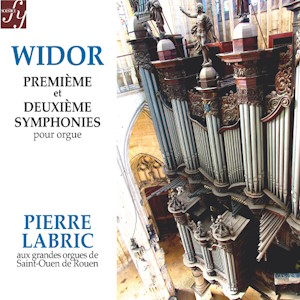
Charles-Marie Widor (1844-1937)
Organ Symphony No. 1 in C Minor, Op. 13 No. 1
Organ Symphony No. 2 in D Major, Op. 13 No. 2
Pierre Labric (organ)
rec. 1971, l’abbatiale Saint-Ouen de Rouen, France
Notes and translations provided in the booklet
Solstice Music SOCD403 [76]
At the end of June this year, the venerable and distinguished French organist Pierre Labric will celebrate his 102nd birthday. A student of Marcel Lanquetuit at the Rouen Conservatory and Marcel Dupré at the Paris Conservatory for organ, he also studied harmony under Maurice Duruflé for which he won his first prize in 1948. He later studied the organ with Jeanne Demessieux, who had also been the most outstanding pupil of Dupré. His discography is extensive, covering the majority of the later nineteenth and twentieth century French repertoire. Most notable were his recordings of the complete organ symphonies of both Widor and Vierne; these were world premiere recordings.
The majority of his recordings were made at Saint-Ouen in Rouen, where the 1890 organ by Aristide Cavaille-Coll is regarded as almost the ideal instrument for the French repertoire, given that it has remained unaltered since completed by its builder. These particular recordings of the first two symphonies by Widor date from 1971. The playing is everything that one could wish for, with Labric’s fidelity to the score ensuring that every tone colour employed is as close as possible to the on which the composer would have had in mind.
However, the recording technology of over 50 years ago had distinct limitations. The quieter movements are more successful, allowing the listener to revel in the richness of the various registers, singly and in combination. Unfortunately, the sheer power of sound generated by the instrument in the louder movements is really too much for the recording. Specifically, the use of the pedal reeds at 16’ and 32’ pitch causes considerable distortion and all but swamps the manual writing. While, in the preparation of this re-issue, every effort has been made to enhance the original recordings, there is a distinct limit to the extent to which this is possible. More recent recordings of the organ capture the sound very much better. Nevertheless, Labric’s authoritative interpretations are well worth hearing and studying, since he must be almost the last living link with the nineteenth century tradition of composition and organ playing from which he benefited and of which he is such a distinguished exponent.
Martyn Strachan
Availability: Solstice Music


















